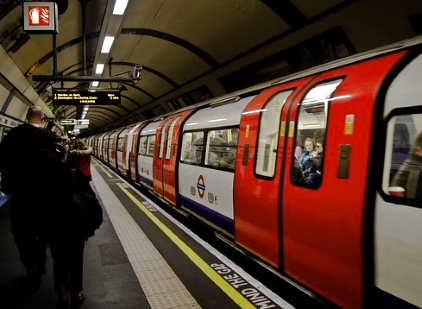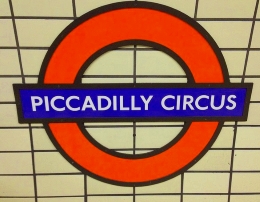Until recently, the largest subway network in the world: The London Underground system is about 400 km long. It was the longest subway network in the world until a few years ago. The metros of Shanghai and Beijing have now (as of 2022) overtaken London in terms of network length. However, the title of “oldest subway in the world” will remain in London forever. The first underground train ran as early as 1863, at that time still with steam locomotives.

Overview: The London Underground is operated by the Transport of London company. The system has about 265 stations, about half of which are underground. Officially, the London Underground has 11 lines. However, these lines often have branch lines, so in reality there are actually far more than 11 lines. The older lines run in very narrow tubes, while the newer subways run in modern, wide tubes.
Officially, the London Underground is called “Underground”, but many people simply call it Tube. The common international name “Metro” is rarely used, but the English understand the term.
Tip: Harry Potter 2024 Excursion (Warner Brothers Studio Tour)One of the popular excursions in London is to the film studios, where the Harry Potter films were shot. The location of the studios is about 30 kilometres north of London near the town of Watford. The tour includes a bus transfer from London and has very good reviews. A “must” for every Harry Potter fan on holiday in London. The trip by bus and the visit to the film studios takes around 7 hours. You should book early, the popular Harry Potter excursion from London is often sold out. The alternative journey by public transport is not so easy. The excursion to the Warner Brothers Studios is for many London holidaymakers the highlight of their trip. >>>>> On this page you can find more info and book the tour.
|
Information about tickets and fares can be found on this page
Lines
The 11 main lines have the same colors on all plans. Unfortunately, the blue of the Piccadilly Line and the Victoria Line is relatively similar, which sometimes leads to confusion.
 The red circle is the famous symbol of the Underground.
The red circle is the famous symbol of the Underground.
Names of the lines: They are not numbered, but have the following 11 names: Bakerloo Line, Central Line, Circle Line, District Line, Hammersmith & City Line, Jubilee Line, Metropolitan Line, Northern Line, Piccadilly Line , Victoria Line, Waterloo & City Line.
The Central Line is now the most important underground line in London, carrying nearly 300 million passengers a year. The Central Line is also the longest line with a length of over 74 kilometers. The Waterloo & City Line, on the other hand, is the shortest line at only 2.4 kilometers. The Circle Line runs in a circle around the city center, similar to the Ringbahn in Berlin.
italy-sights.info/colosseum_rome
Our tip: London PassThe best city ticket for tourists. It includes free entry to the Tower, London Zoo, Westminster Abbey, Windsor Castle and The Shard skyscraper. Plus a city tour by bus and a great boat trip on the Thames. A total of about 85 attractions included! The London Pass is available for 1 day or several days (up to 10 days). Pays off for almost every tourist who wants to visit the sights and the city of London. Our recommendation for a city trip to London! >>> More info and booking |
The 11 lines of the London Underground (tube)
Bakerloo Line:
The Bakerloo Line connects Harrow & Wealdstone in north-west London with Elephant & Castle in the south-east. It is shown in brown on the Tube map. The line opened in 1906 and is named after its two termini, Baker Street and Waterloo. It has 25 stations and covers a distance of about 23 km.
Central Line:
The Central Line runs from Epping in the north-east to Ruislip and Ealing Broadway in the west. It is marked in red on the Underground map. The line opened in 1900 and was the first electric underground in London. It has 49 stations and covers a distance of about 74 km.
Circle Line:
The Circle Line is a ring line running from Hammersmith in the west to Edgware Road in the north, Tower Hill in the east and back to Hammersmith in the west. Yellow on the Underground map. The line opened in 1863 and is the oldest underground line in the world. It has 36 stations and covers a distance of about 27 km.
District Line:
The District Line runs from Upminster in the east to Wimbledon, Richmond, Ealing Broadway and Kensington (Olympia) in the west. It is shown in green on the Underground map. This line opened in 1868 and is the busiest of all Underground lines. It has 60 stations and covers a distance of about 64 km.
Hammersmith & Cityline:
The Hammersmith & City Line runs from Hammersmith in the west to Barking in the east. It is shown in pink on the Underground map. This line opened in 1864 and is the oldest Underground line still in operation. It has 29 stations and covers a distance of about 25 km.
Jubilee Line:
The Jubilee Line runs from Stanmore in the northwest to Stratford in the east. It is shown in silver on the Metro map. This line opened in 1979 and is one of the newest Underground lines. It has 27 stations and covers a distance of about 36 km.
Metropolitan Line:
The Metropolitan Line connects Aldgate in the east with Amersham, Chesham and Watford in the northwest. It is shown in purple on the Metro map. The line opened in 1863 and was the world’s first underground railway. It has 34 stations and covers a distance of about 67 km.
Northern Line:
The Northern Line is divided into two branches, the Charing Cross branch and the Bank branch. The Charing Cross branch runs from Morden in the south to Edgware and High Barnet in the north. The Bank branch runs from Morden in the south to Kennington, Bank and High Barnet in the north. It is marked in black on the road map. The line opened in 1890 and is one of the busiest underground lines. It has 50 stations and covers a distance of about 59km.
Piccadilly Line:
The Piccadilly Line runs west from Heathrow Terminal 5.North Cockfoster. It is shown in dark blue on the Tube map. The line opened in 1906 and is known for serving the major London airports such as Heathrow, Gatwick and Stansted. It has 53 stations and covers a distance of about 71 km.
Victoria Line :
The Victoria Line runs from Walthamstow Central in the north-east to Brixton in the south. It is shown in light blue on the Underground map. The line opened in 1968 and was the first underground line with automatic train control. It has 16 stations and covers a distance of about 21 km.
Waterloo & Cityline :
The Waterloo & City Line stretches from Waterloo in the south to the Bank in the east. It is coloured turquoise on the Underground map. This line opened in 1898 and is the shortest of all the Underground lines. It has only two stations and covers a distance of about 2.5 km.
The most popular excursion by boat on the ThamesMeanwhile, a large proportion of London tourists take a boat trip on the Thames. Of course, everyone wants to see central London from the ship. The most popular boat tour is therefore from Westminster to Greenwich, i.e. across the centre of London. Very frequently booked tour, you should book online in advance: >>> At Getyourguide you can buy tickets for the ships on the river Thames |
Other rail transportation in London
However, there are many other rail-based means of transportation in London.
On the one hand, there is the London Overground. It is a public transportation system comparable to a suburban railroad with about 9 lines. It is mainly used by people in neighborhoods and suburbs further from the center.
There is also the DLR (Dockland Light Railway). This is a modern light rail, automatic without a driver, in and around the old Docklands harbor. The DLR has been around for 30 years and continues to expand (currently 45 stations as of early 2019).
A tramway (streetcar) has also been back in London since 2000. The still small network comprises 4 lines with a total route length of 28 kilometers.
Modern express trains to major airports: Info about train to Heathrow , Info about train to Gatwick.
>>>> Our page about all trains and buses to all major London airports.
Normal local trains to the surrounding areas are also used a lot. Since such railroads stop several times within London, they are also popular among residents and tourists within the city. They are often faster than the Underground because the distance between stops is much greater.
– >>>>>>> More information for tourists including fares
Top 10 London sights on the city map

